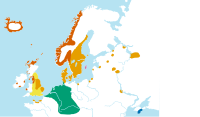
Back Màgia rúnica Catalan Runemagi Danish Magia rúnica Spanish Runomancie French Čitanje runa Croatian Magia runica Italian ルーン魔術 Japanese Magik runik Malay Alfabetmagi NB Рунска магија Serbian
This article includes a list of general references, but it lacks sufficient corresponding inline citations. (November 2017) |
| Part of a series on the |
| Norsemen |
|---|
 |
| WikiProject Norse history and culture |
There is some evidence[citation needed] that, in addition to being a writing system, runes historically served purposes of magic. This is the case from the earliest epigraphic evidence of the Roman to the Germanic Iron Age, with non-linguistic inscriptions and the alu word. An erilaz appears to have been a person versed in runes, including their magic applications.
In medieval sources, notably the Poetic Edda, the Sigrdrífumál mentions "victory runes" to be carved on a sword, "some on the grasp and some on the inlay, and name Tyr twice."
In the early modern period and modern history, related folklore and superstition is recorded in the form of the Icelandic magical staves. In the early 20th century, Germanic mysticism coined new forms of "runic magic", some of which were continued or developed further by contemporary adherents of Germanic Neopaganism. Modern systems of runic divination are based on Hermeticism, classical Occultism, and the I Ching.
© MMXXIII Rich X Search. We shall prevail. All rights reserved. Rich X Search